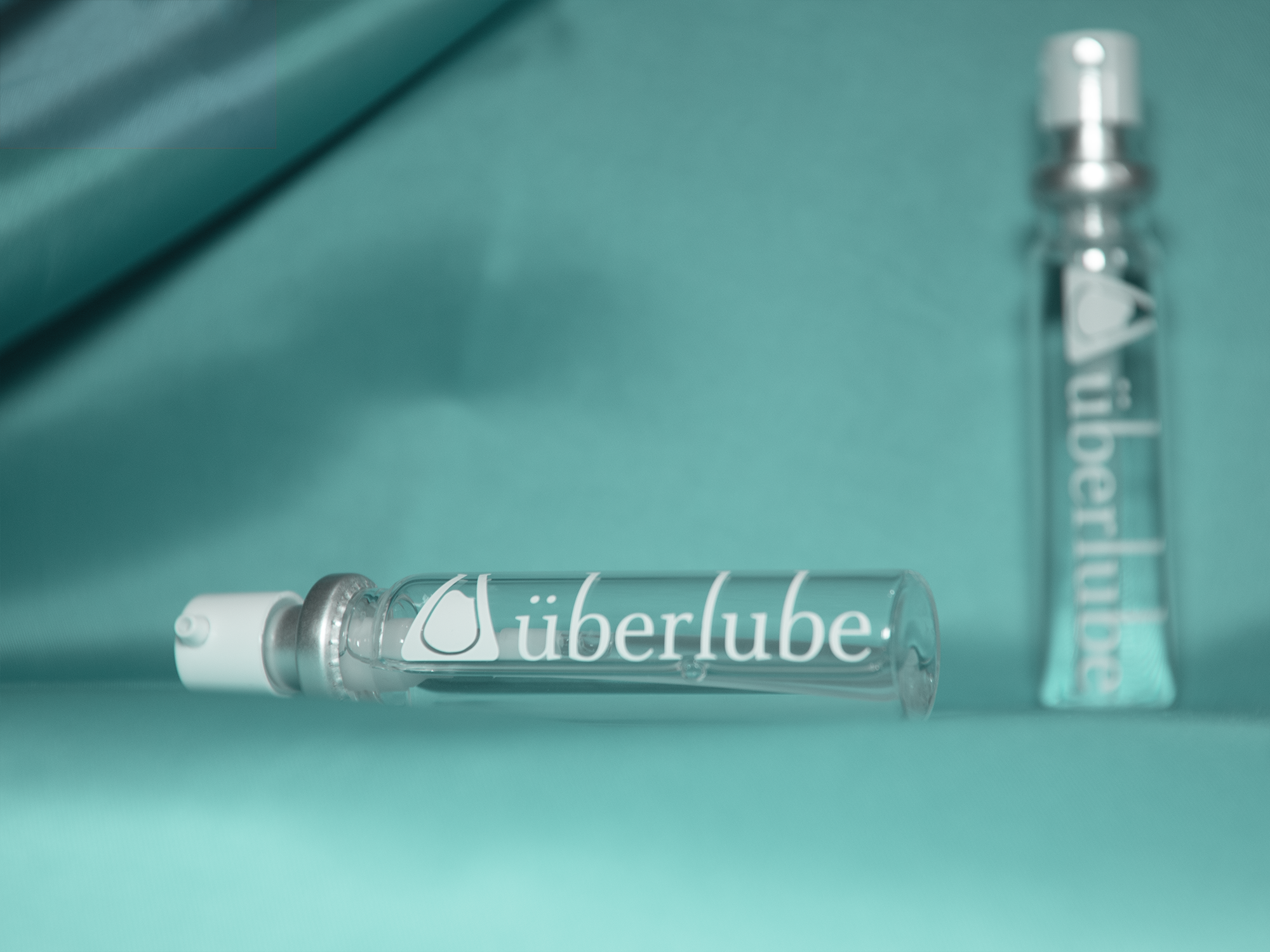Last Updated on October 29, 2025 by Lexi Kisses
Buying a bottle of lube can be a hassle. There are 5 common types of lube out there, and who knows how many others. From water, to silicone based lubes; which one suits your needs? And, how do you know if it’s safe?
The Science
Finding the correct lube for yourself involves learning a little bit of chemistry first. Knowing a lubes’ osmolality, pH and the chemicals that are in it, is the basis of picking out a safe one.
Note: Osmolality and pH generally apply to water-based lubes. This is because silicone and oil-based lubes have no water in them, which is what Osmolarity and pH need for their data.
What to Know About Osmolality
Explaining Osmolality in simple terms is hard.1 After hours of research, I still haven’t found the correct way to phrase it. Luckily, you don’t have to understand the entire concept.
Just know that cells try to maintain homeostasis (maintain stability), so any change to their external environment will cause them to adjust in order to return to their original state.
When we add something new to our cells’ environment, such as lube, we run the risk of affecting this homeostasis. The osmolality of a lube affects this homeostasis and different types of lubes have different osmolalities.
Types of Osmolalities
When discussing Osmolality, there are 3 terms to know; hypo-osmotic, hyper-osmotic, and iso-osmotic.
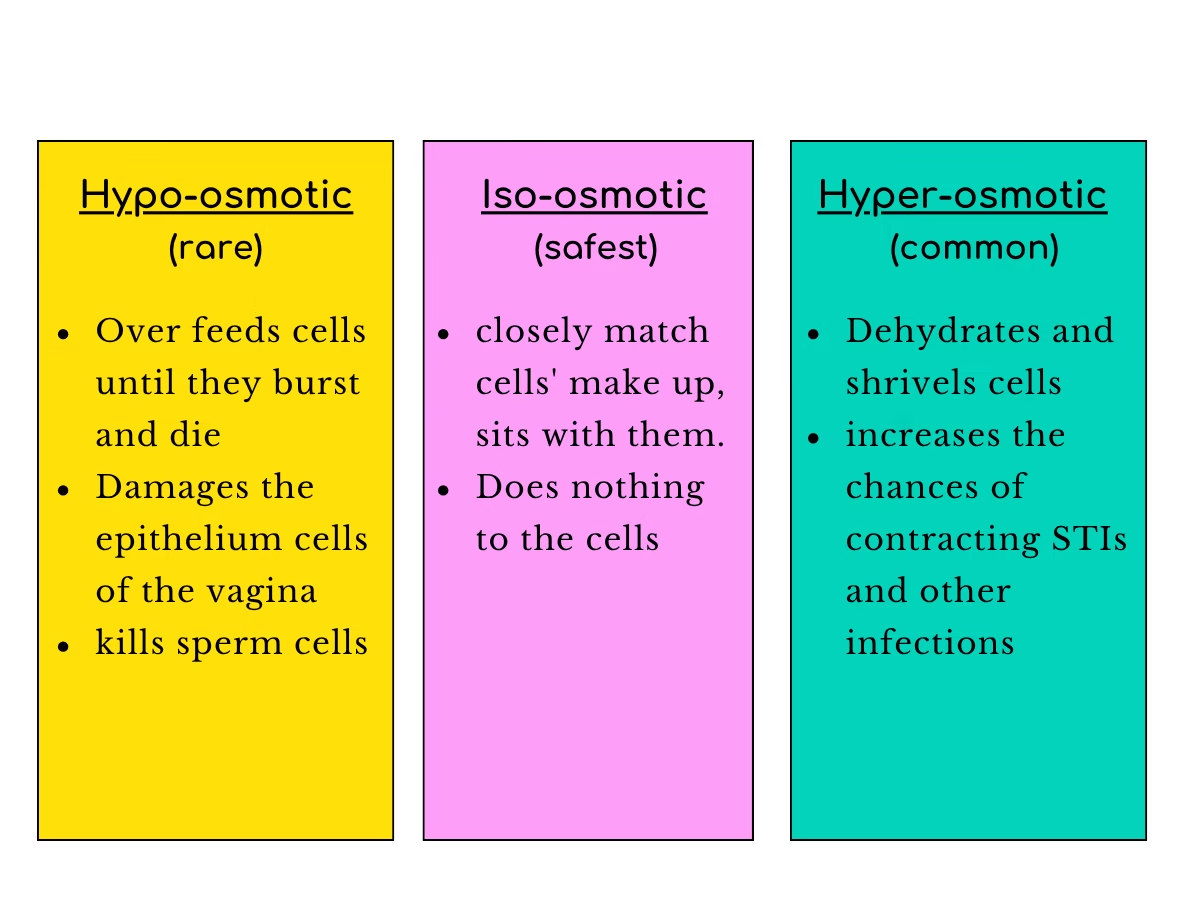
Hypo-osmotic substances will feed your cells so much that they will burst and die as they attempt to maintain homeostasis.
Iso-osmotic substances closely match your cells’ makeup; therefore, they just sit with your cells and do nothing.
Hyper-osmotic substances will dehydrate your cells; leaving them dry and shriveled as they attempt to maintain homeostasis.
When a lube is hypo-osmotic, it will cause damage to the epithelium cells of the vagina and kill sperm cells. These lubes are NOT recommended for anyone, but especially not if you are trying to conceive.1
When a lube is Iso-osmotic, your cells do a happy dance. Iso-osmotic lubes match your cells’ makeup so closely that they do nothing but sit with them when they come into contact. Iso-osmotic lubes are the safest to use.
When a lube is hyper-osmotic, it dries out the cells around it, which increases the chances of contracting STIs and other infections. Unfortunately, most lubes on the market are hyper-osmotic.2
According to the World Health Organization, water-based lubes should be at least below 1200 mOsm/kg to be safe.3
The general rule of thumb is the closer it is to our bodies’ natural osmolarity, the better, which for a human is around 275 to 295 mOsm/kg (lubes with osmolarities of 300 mOsm/kg are the safest).4
Note: Most lubes do not have osmolality test results. To find out if the lube you are looking at has, a quick search of “lube name osmolality” may help.
The Basics of pH Balance
pH balance, in simple terms, is the scale that measures how acidic or basic a water-containing substance is. 5
The scale ranges from 0-14, with 0 being the most acidic and 14 being the least. The middle of the scale, which is 7, is considered neutral (neither acidic nor basic); a prime example of this is pure water.
Different types of lubes have different pH numbers; part of keeping your body healthy is keeping your pH balanced.
Imbalances can occur if you use a lube with a drastically different pH from the part you use it on.6 These imbalances leave the area susceptible to infection and can cause burning or discomfort.
How to Use pH
When buying a lube, to avoid irritation and infection, the pH balance should closely fall into the same pH range as whatever internal part you plan to use it for. Just because it’s ok for the vagina doesn’t mean it’s ok for anal and vice versa.
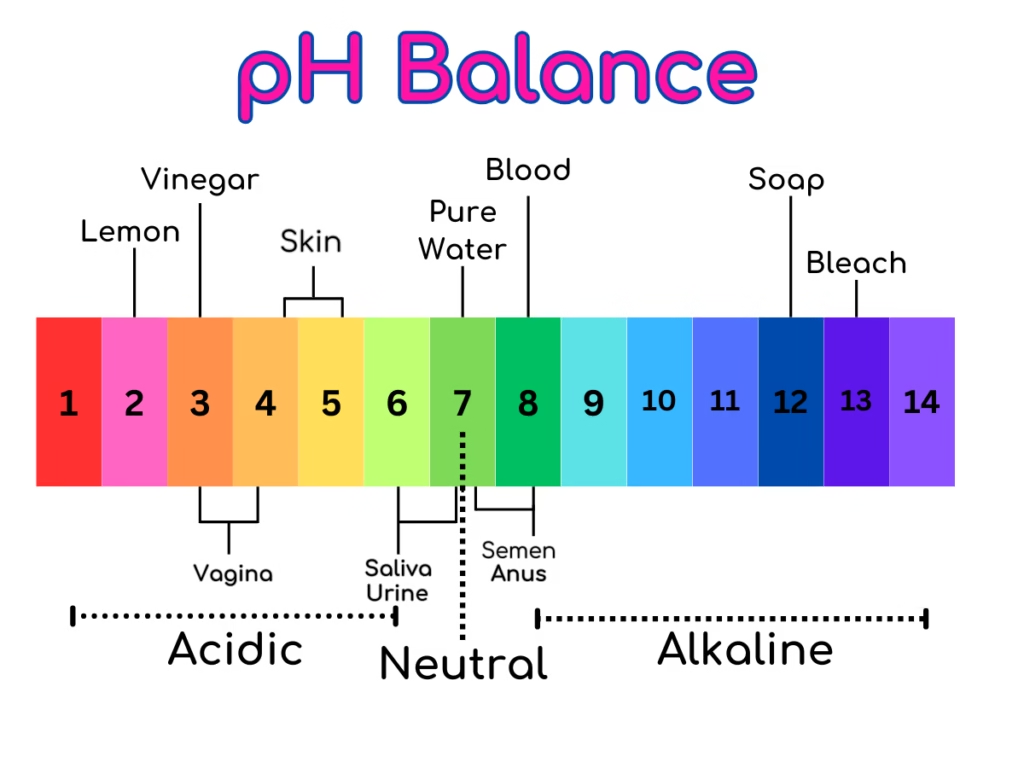
The vagina has a pH that ranges between 3.5-4.5, which makes it slightly acidic. This acidity kills off bacteria, such as those that cause yeast infections.
Using a lube that has a significantly high pH can spike up the pH in the vagina, making it unable to kill the bacteria effectively. This leads to an increase of bacteria in the vagina, which increases the likelihood of vaginal issues.7
When looking for a vaginal lube, it’s best to look for a pH that falls under 7.
The pH of the anus ranges from around 7-8, which makes it slightly basic. Using a lube that has too low of a pH will be too acidic. This can cause irritation and tissue damage to the area.8
When using a lube for the anus, look for a pH of around 6 and up.
Note: Lube companies don’t put the pH directly on the package. You can find out the pH on your own with either a quick Google search or using some pH test strips.
Watch Out For Chemicals
Parabens (Maybe)
Parabens are additives that help prevent bacteria and mold from growing in lube.
There have been some studies that suggest parabens can cause cancer, but many of them were conducted under flawed and extreme circumstances.9 It’s widely up for debate on whether you can even use enough lube in your lifetime for it to have cancer-causing effects.
Either way, paraben-free is beneficial because the fewer chemicals in your lube, the better, but don’t automatically think paraben-free means safe.
Fragrances
Sometimes, certain types of lubes add fragrances to their ingredients to create a more appealing smell. As alluring as that may sound, it doesn’t come without downsides. Fragrances, including natural ones, are too harsh to use on the vagina or anus and can cause irritation.7
Nonoxynol-9
To make safe-sex products more effective, companies add the spermicide Nonoxynol-9 to condoms and lubes. It was once believed to kill bacteria that cause STIs. However, that is no longer true, new studies show it increases someone’s chances of contracting an STI.
Along with these chances, Nonoxynol-9 also irritates and kills off the cells in the vagina and anus.10
Glycerin & Propylene Glycol (Water-based)
Glycerin is an alcohol-based sugar commonly found in water-based lubes. Propylene Glycol is a thick chemical liquid that is sweet. Both of these chemicals are in water-based lubes for the same two reasons.
One, it helps substances retain their moisture, which helps the lube stay slippery longer.11 And two, glycerin is sweet, which makes it perfect for flavoring lubes.
The issue with these two substances is that they both have been known to have adverse effects.
When used in the vagina, some data suggest glycerin & propylene glycol can cause an overgrowth of bacteria leading to an increased chance of bacterial & yeast infections.12
Another issue is adding these to a substance increases the osmolarity.10 And, as we learned in the previous section, an increase in osmolarity is an increase in the user’s susceptibility to contracting STIs and other infections.
Silicone Lube (maybe) Watch-Outs
- (Octamethyl-) Cyclotetrasiloxane (D4),
- (Decamethyl-) Cyclopentasiloxane (D5)
- Dimethicone (Polydimethylsiloxane)
There’s a small chance that D4, D5, and dimethicone could be endocrine disruptors. Which may potentially have toxic effects on reproductive health.
But, the research and data backing up these claims are weak.13
Many professionals believe that because silicones sit on top of our skin instead of absorbing into it, that they may pose little to no risk to us.14
In general D4, D5, and dimethicone are considered safe for human use.15
With such limited research on the topic, I advise that you use lubes that contain these silicones with awareness and caution.
TL;DR Science Summary
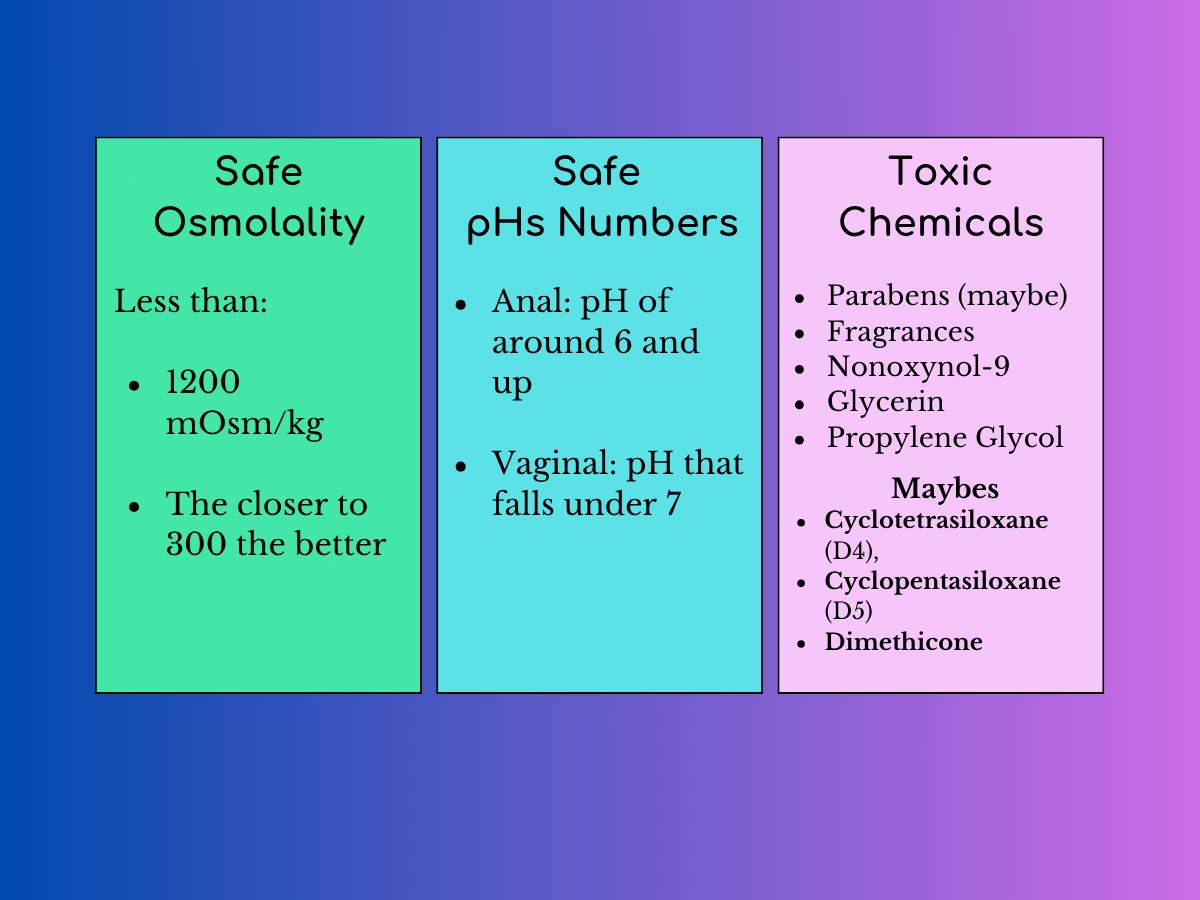
The Types of Lubes
Water-based Lubes
Water-based lubes are by far the most common type out there. This is probably because they are extremely versatile.
These lubes are easy to clean, don’t stain fabrics, and are compatible with all toys and condoms. They go on slippery and, within moments, turn into a sticky substance.
And, that’s where the downsides start.
With these lubes you need to reapply them often for them to stay slick. To combat this issue, lube companies tend to add ingredients that raise the osmolality of the lube. Which, as I mentioned earlier, causes issues.
They’re easy to clean nature makes them the worst option for shower sex, because they just wash off. And, Water-based lubes have varying pH levels, making it impossible to buy only one for all your orifices.
Silicone-based Lubes
Silicone lubes apply silkily and keep their slide until you wash them off with soap.
These lubes are condom safe and seemingly body-safe. They have no issues with osmolality and are pH neutral, so they won’t cause any changes to your levels. This neutrality makes it a safe option for both anal and vaginal intercourse.
They are not, however, safe to use with silicone toys. Because silicone polymers are known to bind to other silicone polymers when they come into contact, using silicone lube with silicone toys could potentially damage and degrade the toy.
Silicone lubes have also been known to stain fabrics.
Oil-based Lubes
Oil/Oil-based lubes are lubes that are just that; oil! This can range from using 100% natural cooking oils such as coconut oil; or a store-bought lube that blends an oil with another ingredient such as aloe.
Using oil as a lubricant is highly debated and rarely researched.
On one hand, we have the benefits: it’s slippery, convenient, long-lasting, silicone-safe, and water-proof.
On the other hand, there are the negatives.
Oil degrades latex, rubber & PVC, which makes it NOT SAFE TO USE WITH condoms, PVC, TPE, or TPR toys. It can clog pores, which may lead to infection. And, the excess oil build-up may create a breeding ground for yeast, so it’s not recommended for vaginal play.7
Oil tends to be risky because it easily collects bacteria.
It’s recommended to use it with caution and to listen to your body. Not everyone will have an issue with it, and the research is limited.
Hybrid Lubes
Hybrid Lubes are Water-based lubes with a small amount of silicone added. Adding silicone to water-based lubes makes them last longer and reduces their sticky residue. The final product is also compatible with all types of toys and condoms due to its mixed makeup.
Even though we are not entirely sure how silicone affects the overall osmolality of the lube, we do know that silicone itself doesn’t create changes to osmolality and is generally safe to use as an additive in water-based lubes.
Flavored Lubes
Flavored lubes should NOT be used internally on either the anus or the vagina. They tend to dry out and get tacky quickly which increases the chance of discomfort in the anus. Along with that, a lot of these lubes use glycerin for sweetness which is known to cause excess bacterial growth in the vagina.
Flavored lubes are best used for giving blow jobs (with or without a condom), or licking off external erotic areas of the body.
TL;DR Types Summary
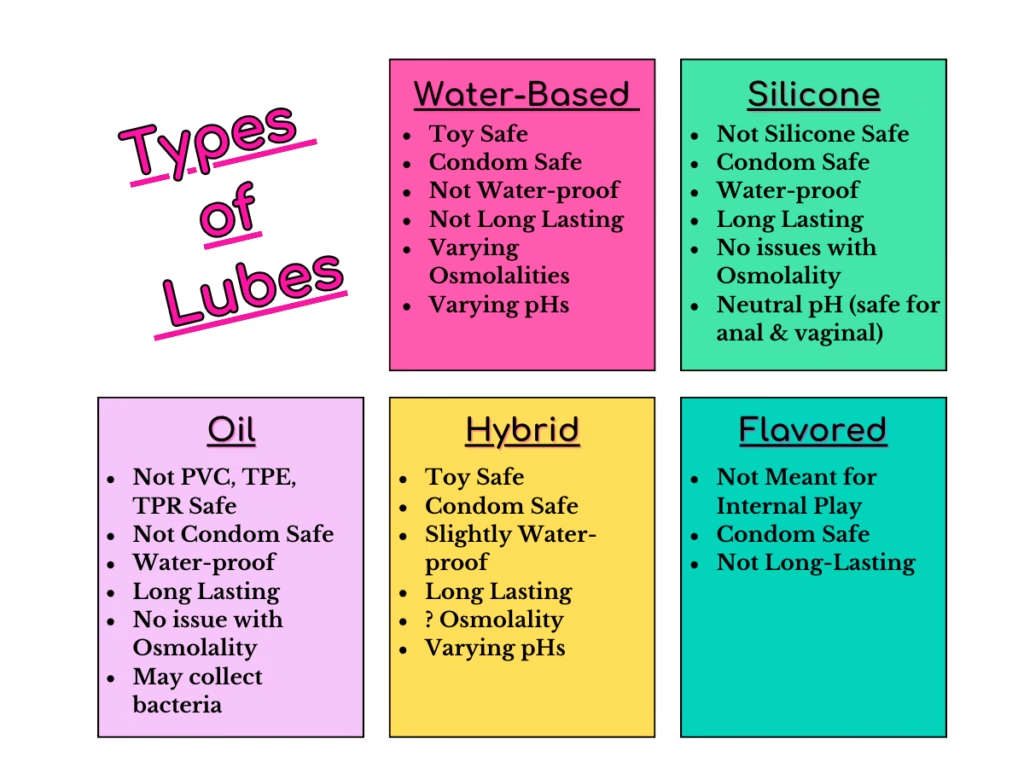
Final Thoughts
One day, maybe all types of lubes will come with a nutrition style label with all the information we need on the bottle. Until then, buying lube can be a task. From unethical practices, to lack of knowledge, finding a safe lube is work. So, good luck and happy fucking!
Have you found your go to brands? What has your experience with lube been? I’d love to know in the comments!
- Lilly, Dangerous. “The Big Lube Guide.” DangerousLilly, 1 Mar. 2016, dangerouslilly.com/lube-guide/. Accessed 17 Jan. 2024.[↩][↩]
- Ayehunie, Seyoum, et al. “Hyperosmolal Vaginal Lubricants Markedly Reduce Epithelial Barrier Properties in a Three-Dimensional Vaginal Epithelium Model.” Toxicology Reports, vol. 5, 2018, pp. 134–140, www.sciencedirect.com/science/article/abs/pii/S0273230020302063, https://doi.org/10.1016/j.toxrep.2017.12.011. Accessed 24 Oct. 2025.[↩]
- The World Health Organization (WHO, and United Nations Population Fund (UNFPA) . Annex 11 World Health Organization/United Nations Population Fund Specifications for Plain Lubricants Background. 30 Sept. 2020, pp. 256–58, www.who.int/docs/default-source/medicines/norms-and-standards/guidelines/trs1025/trs1025-annex11.pdf?sfvrsn=3dd1e3bb_2. Accessed 17 Jan. 2024.[↩]
- Najem, Omer, et al. “Serum Osmolality.” PubMed, StatPearls Publishing, 2021, www.ncbi.nlm.nih.gov/books/NBK567764/. Accessed 17 Jan. 2024.[↩]
- Brown, Emily. “What Is PH Balance?” Verywell Health, 26 Apr. 2022, www.verywellhealth.com/ph-balance-significance-function-associated-conditions-5205825. Accessed 17 Jan. 2024.[↩]
- Łaniewski, Paweł, et al. “Clinical and Personal Lubricants Impact the Growth of Vaginal Lactobacillus Species and Colonization of Vaginal Epithelial Cells: An in Vitro Study.” Sexually Transmitted Diseases, vol. 48, no. 1, Aug. 2020, pp. 63–70, https://doi.org/10.1097/olq.0000000000001272. Accessed 24 Oct. 2025.[↩]
- Ryleigh Vanderschee, and Sanja Kostov. “Approach to Lubricant Use for Sexual Activity.” Canadian Family Physician, vol. 71, no. 7-8, College of Family Physicians Canada, July 2025, pp. e158–66, https://doi.org/10.46747/cfp.710708e158. Accessed 24 Oct. 2025.[↩][↩][↩]
- SUDOL, KRISTIN M., and DAVID M. PHILLIPS. “Relative Safety of Sexual Lubricants for Rectal Intercourse.” Sexually Transmitted Diseases, vol. 31, no. 6, June 2004, pp. 346–49, https://doi.org/10.1097/00007435-200406000-00005. Accessed 24 Oct. 2025.[↩]
- Edwards, D., and N. Panay. “Treating Vulvovaginal Atrophy/Genitourinary Syndrome of Menopause: How Important Is Vaginal Lubricant and Moisturizer Composition?” Climacteric, vol. 19, no. 2, Dec. 2015, pp. 151–61, https://doi.org/10.3109/13697137.2015.1124259. Accessed 24 Oct. 2025.[↩]
- World Health Organization 2012. “Safe Lubricants for All – Procurement Specifications for Lubricants Used with Male and Female Condoms (Technical Brief).” United Nations Population Fund, 2022, pp. 3-4, iris.who.int/server/api/core/bitstreams/c0d0726b-e941-4d63-9647-fe2c2a52438a/content. Accessed 27 Oct. 2025.[↩][↩]
- Kiehl’s Education Team. “What Does Glycerin for Skin Do? | Kiehl’s.” Kiehl’s – Naturally Inspired Skin Care, Body and Haircare, www.kiehls.com/skincare-advice/glycerin-skin-benefits.html. Accessed 17 Jan. 2024.[↩]
- Nicole, Wendee. “A Question for Women’s Health: Chemicals in Feminine Hygiene Products and Personal Lubricants.” Environmental Health Perspectives, vol. 122, no. 3, Mar. 2014, https://doi.org/10.1289/ehp.122-a70. Accessed 17 Jan. 2024.[↩]
- Wolfgang, Dekant, and Klaunig James . “Toxicology of Decamethylcyclopentasiloxane (D5).” Regulatory Toxicology and Pharmacology, vol. 74, Feb. 2016, pp. S67–76, https://doi.org/10.1016/j.yrtph.2015.06.011. Accessed 28 Oct. 2025.[↩]
- Jean, Paul A., et al. “Effects of Chronic Exposure to Octamethylcyclotetrasiloxane and Decamethylcyclopentasiloxane in the Aging Female Fischer 344 Rat.” Toxicology Letters, vol. 279, Elsevier BV, Oct. 2017, pp. 54–74, https://doi.org/10.1016/j.toxlet.2017.08.016. Accessed 28 Oct. 2025.[↩]
- Dayan, Nava. Handbook of Formulating Dermal Applications. Edited by Nava Dayan, 2016, repository.poltekkes-kaltim.ac.id/1181/1/26.%20Handbook_of_Formulating_Dermal_Applications.pdf. Accessed 28 Oct. 2025.[↩]



